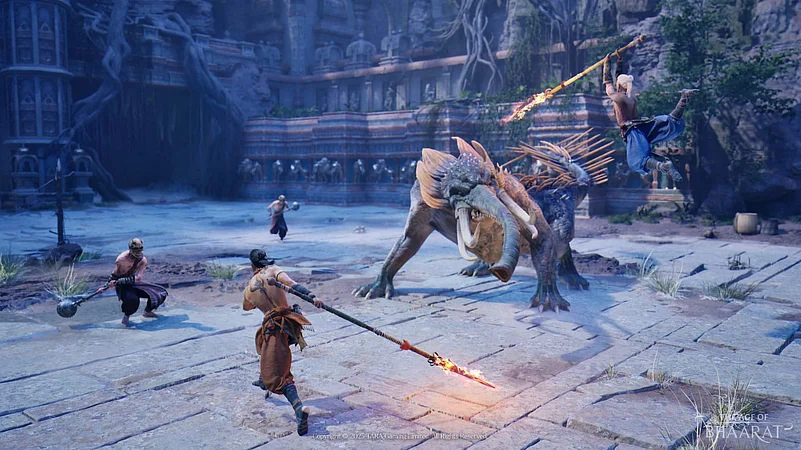A gaming startup is aiming to do for Indian mythology what Assassin’s Creed did for European history. Tara Gaming, co-founded by gaming veteran Nouredine Abboud, bestselling author Amish Tripathi, and with actor Amitabh Bachchan onboard, is building The Age of Bhaarat, an ambitious AAA title inspired by the Ramayana. The project is part cultural moonshot, part commercial bet on the world’s fastest-growing youth market—and it may be India’s most serious play yet at exporting its narrative traditions through interactive entertainment.
Abboud, who has built billion-dollar games before, says the goal is nothing short of “creating the biggest game ever done about Indian mythology.” The project is being developed by a globally distributed team of 130, including 30 staff in Pune, and aims to scale to over 300. Tripathi, whose mythological fiction has already found a global readership, is co-writing the narrative, which features a grassroots resistance movement set against the mythic backdrop of forest tribes and rakshasas. The game may also include Bachchan as a non-playable character.
Tara Gaming says the game’s ambitions extend beyond India’s borders, positioning Age of Bhaarat as a vehicle for cultural soft power and commercial success. “Gaming is the culture today,” says Abboud. “Everything else is the subculture.”
With production budgets reportedly running into the tens of millions of dollars, the game could redefine India’s presence in the global AAA arena. In an interview with Outlook Business, Tara Gaming co-founders Nouredine Abboud and bestselling author Amish Tripathi pull back the curtain on The Age of Bhaarat.
How did it all start?
Nouredine: I’ve been working in the industry for quite a while. After working on a number of games in big companies, I started working with a group of developers and investors. During the discussions we had, at one stage we had the opportunity to start thinking about doing something with India.
At that moment, we reached out to Amish because we believed he’s the best talent to bring Indian mythology to life. He has a track record and is known not only as a writer but also as an influencer. He has credibility. We were lucky because he was excited about joining this adventure. Then, at one stage, he put us in contact with Amitabh Bachchan. As someone who has an important role in the cultural scene in India, he has strong connections and sage advice..
Amish: For me, I was first approached by Nikola Granatino, the chairman of Tara Gaming.
I’ll be honest, I knew very little about gaming. I’m not a gamer. My son is a very ardent gamer. It was only through him. I spoke to him and asked if he’d like me to do this, and he immediately said, “Yes, yes, Dad, you must.” Gaming is huge for kids. For me, it was a process of discovery, that’s when I realised how big gaming really is.
We like to think that gaming is a subculture and the rest of us — movies, books, music — are the main culture. Actually, it’s the other way around. We are the subculture. Gaming is the main culture. It’s bigger than movies, books, music, and theatre combined especially among the youth. So if you want to impact the cultural conversation, this is where you have to be.
The kind of obvious subject that selects itself for a AAA game is the stories of our itihasas and our legends. If you see some of the other non-Western successful AAA games that have come, like Black Myth: Wukong of China, it's based on their traditions. It's based on a historical book called The Journey West, which is an ancient Chinese classic.
Chinese, Korean, Japanese games have become an instrument of soft power for those countries. Can Age of Bharat be exported? Is the West also your target audience?
Amish: There is no doubt that gaming is the perfect way to get our narrative and our way of looking at the world across because kids play games and then they get influenced by those games.
There's a friend I know who'd gone to Paris for the first time with his kid, and his kid recognized many of the locations in Paris because he played Assassin's Creed. It's the same thing which the Age of Bharat can do. Black Myth: Wukong did this for Chinese soft power across the world.
At the recent Waves conference, Modi had spoken about the power of video gaming and how it is influencing our children and children actually across the world.
He laid out his vision that we must have high-quality games which appeal to the youth. As far as I'm aware, he's the senior-most political leader who's spoken of the importance of gaming not just from an economic perspective, but also from a cultural perspective.
Nouredine: Right now, from a pure time-spent perspective, if you want to influence today's world and especially the future of this planet, the gaming medium is probably the only way. We're not talking about real money gaming or addictive mobile games. We're talking about the most exciting visually, culturally, emotionally rich games, those big blockbuster games that are shaping the fantasy of millions of people all over the world. For us, actually, it was a surprise that nobody was doing this in India.
The second thing is that if you look strictly from a money point of view, it would be too small to only focus on the Indian market as we are talking about a project that would cost multiple tens of millions of dollars. Just to be clear, I'm not going to go into the details of the budget of the project, but what I can tell you is that projects like that take between two to five years to develop, between 300 and a thousand people, and the budgets are between $50 million and $200 million.
India has always had these great mythologies. These mythologies have also been traveling across Southeast and South Asia even 1,500-1,000 years back and took different forms. However, we have not been able to do that at a commercial level in the last 70-80 years. Why has our film industry and the broader media industry lagged behind?
Amish: One reason is we didn’t have the money. We were a poor country. We simply couldn’t put up productions that could be world class simply because we didn’t have the money. As Nouredine told you, an AAA game is a very expensive project. Even the Ramayana that Namit Malhotra is working on a kind of budget that wouldn’t have been possible 10–15 years ago, maybe even 5 years ago. Second is the influence of India. Our culture spread to other countries 1500 years ago when India was the largest economy in the world. But as our economy and hard power collapsed, so did our soft power.
Those are the two broader issues which creative people can do very little about. But there is a third thing which creative people can do something about, which is: how do we write and communicate our stories? Do we have that obsession with quality that will actually make it world class? We shouldn’t have a chalta hai attitude just because our stories are very good. If the quality is good, it travels abroad. My books sell abroad. RRR sold abroad. The Age of Bharat will do it as well.
Everybody is talking about how AI is going to cut costs in game development. Do you think it presents a better opportunity for India to develop AAA games because of AI?
Nouredine: I don’t believe this at all. I think it’s a complete lie. When a tool comes, it’s never used to reduce the cost. It’s used to make better games.
Entertainment, and gaming especially, is about magic. It’s about seeing incredible things. We don’t look at it as, “OK, I’m going to spend less.” We say, “Wow, I’m going to create even more breathtaking, incredible images.”
When VFX and special effects arrived, you could say, “OK, now I don’t need to shoot on location. I can recreate the area in the studio, so I’m going to reduce the cost of the movie.” It didn’t happen. The contrary happened. All of a sudden, every big Marvel movie had those incredible VFX and the costs ballooned.
There’s no reason why AI would specifically be different for India than it would be for another country. Of course, all my developers have access to all the tools. And yes, having those tools to be able to make quick prototyping, quick drafts, quick image search of course.
Has it helped in any way in your writing?
Amish: AI is actually a great research tool. But I'm not so sure about its writing skills at this point of time. I think someone could use AI to write an article. An entire book or a film script? I don't think so.
Are you working with Mr. Bachchan on the narrative of this game? Is that something you can share?
Amish: He’s of course done a fantastic voiceover, which you’ve seen in the trailer. But beyond that, there’s an idea we’re developing: can we have Mr. Bachchan as an NPC (non-playable character) in the game?
We’re exploring the possibility of creating a character where Mr. Bachchan is a meaningful NPC who plays an active role in the narrative. I think that would be a very exciting idea, and we’re working on it.
Are you developing the storyline of the game? And is that something you're working on?
Amish: I'm working with the team. It’s a multinational team from the UK, France, Canada, Belgium. These games are actually really large, massive projects. Even an Indian film crew is tiny compared to the kind of team we already have. Just the amount of content that we write is equivalent to around, you know, 15-20 books. You have to have that in an average AAA game.
Is the game adapted from a particular mythological tale?
Amish: I'm not saying too much right now, but at a broader level, think of it as: there is a war happening at the meta level, where Lord Ram has attacked the Rakshasas who are oppressing the forest tribes of Dandakaranya. The Rakshasas, as you know, are the army of Ravana. And that is the war that is happening at the meta level.
But what happens if you're a forest warden? You're at the village level, right? And you and your people are being oppressed by the Rakshasas. And now that you know the Rakshasas at the top level are being fought by someone like Lord Ram, you gather courage as well to fight the local Rakshasas. So it is set in Ramayana. It's set in that world. But no, you don't get to play Lord Ram. That will be controversial. But it's set in that world.



























